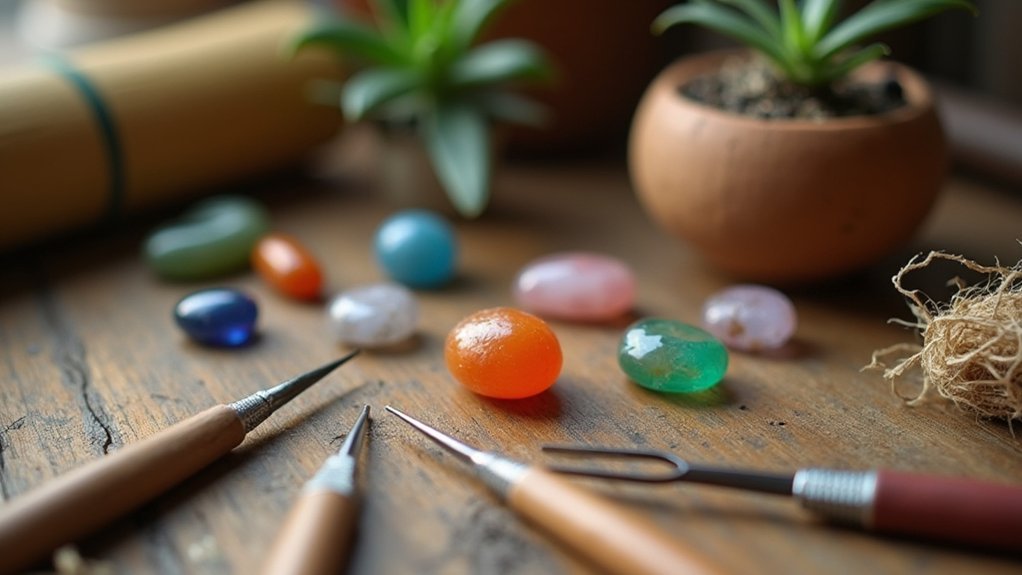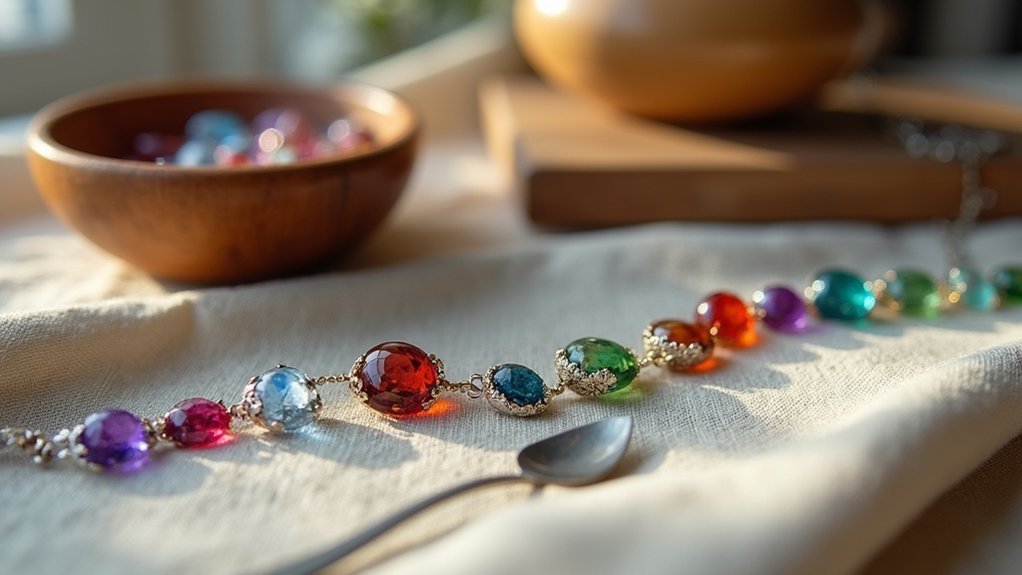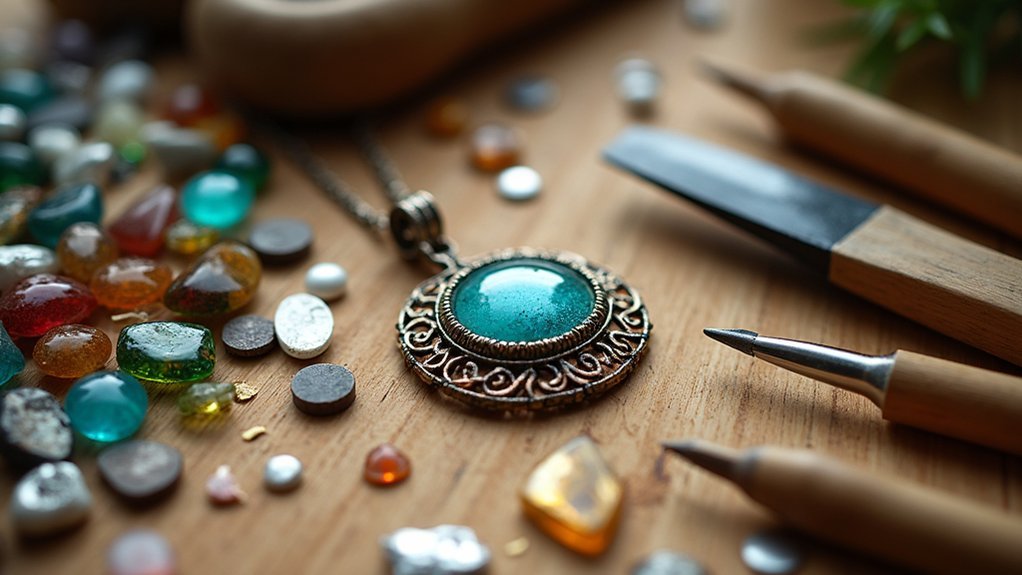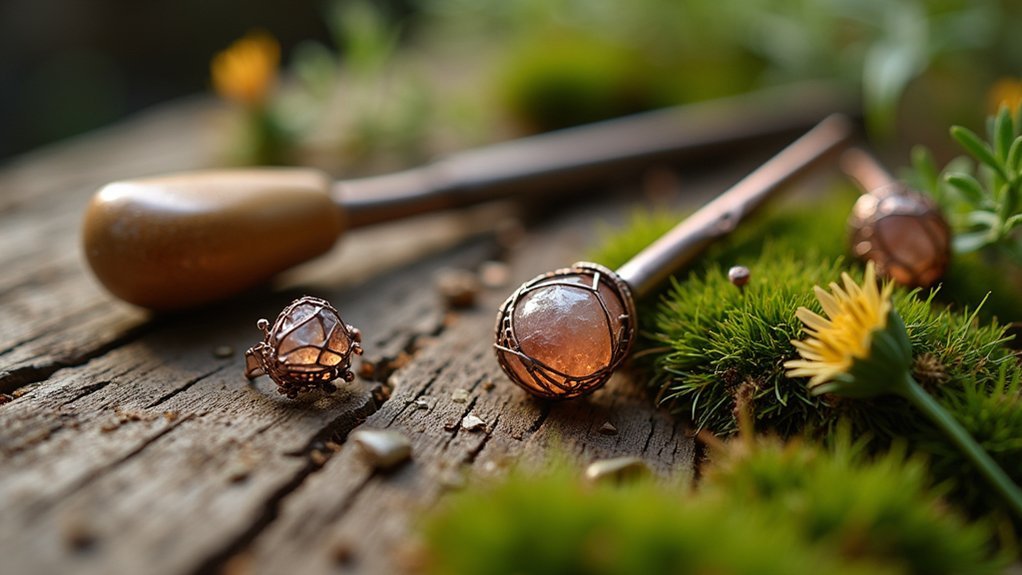You’ve probably admired stunning jewelry pieces without considering their environmental cost. Traditional jewelry production devastates ecosystems through mining, generates massive carbon emissions, and often exploits workers in developing nations. But there’s a growing movement transforming this industry from the ground up. Sustainable jewelry makers are revolutionizing how precious metals and gems reach your collection, using innovative techniques that’ll challenge everything you thought you knew about luxury accessories.
Understanding the Environmental Impact of Traditional Jewelry Production

When you purchase traditional jewelry, you’re likely unaware that a single gold wedding ring requires the excavation of 20 tons of earth, leaving behind a trail of environmental destruction.
Behind every gleaming gold ring lies 20 tons of excavated earth and immeasurable environmental devastation.
Traditional jewelry production creates devastating environmental impact through mining operations that cause widespread deforestation and ecosystem destruction. The Amazon alone lost 4,500 square miles between 2005 and 2015 due to mineral extraction.
Mining processes rely on toxic chemicals like cyanide and mercury, contaminating water supplies and destroying agricultural land. The industry’s carbon footprint is staggering—producing one gold ring generates 57 kg of CO2 emissions.
Additionally, one million children work in dangerous mining conditions. Understanding these consequences highlights why sustainable practices and ethical sourcing matter when choosing jewelry.
Recycled Precious Metals: Transforming Waste Into Wearable Art
You’ll find recycled precious metals come from old jewelry, electronic waste, dental work, and industrial scraps that would otherwise end up in landfills.
When you choose recycled gold or silver, you’re cutting CO2 emissions by up to 99% compared to newly mined metals while eliminating the need to excavate tons of earth.
These reclaimed materials don’t compromise on quality—they’re refined to the same purity standards as virgin metals and often develop unique textures that make your jewelry even more distinctive.
Sources of Recycled Metals
Transformation lies at the heart of sustainable jewelry making, where discarded materials become tomorrow’s treasured pieces. You’ll find recycled metals sourced from three primary streams: old jewelry, electronic waste, and industrial scrap.
These sustainable materials dramatically reduce environmental impact while conserving natural resources. Your discarded smartphones and computers contain recoverable gold, silver, and platinum that ethical jewelry brands can transform into stunning pieces.
When you choose recycled gold over newly mined alternatives, you’re supporting fair labor practices and ethical sourcing. Electronic waste provides particularly rich sources of precious metals, while vintage jewelry offers high-quality materials ready for refinement.
Industrial manufacturing processes also generate metal scraps suitable for recycling. This environmentally friendly approach helps reduce waste while maintaining the quality standards you expect from fine jewelry.
Environmental Impact Reduction
Because mining a single gold ring requires extracting up to 20 tons of earth, choosing recycled precious metals creates an immediate and measurable environmental impact reduction. You’re supporting sustainable production methods that slash carbon emissions by 57 kg per ring while using 90% less energy than traditional extraction.
| Impact Category | Traditional Mining | Recycled Metals | Environmental Benefit |
|---|---|---|---|
| Earth Extraction | 20 tons per ring | Zero new mining | Preserves natural landscapes |
| Energy Consumption | High extraction costs | 90% less energy | Dramatic efficiency gains |
| Carbon Emissions | 57 kg CO2 per ring | Minimal emissions | Climate protection |
| Waste Stream | Creates mining waste | Diverts landfill materials | Circular economy support |
Your eco-friendly practices transform discarded electronics and old jewelry through repurposing materials, minimizing mining while enabling unique craftsmanship. This waste reduction approach makes every piece environmentally responsible.
Quality and Durability
Recycled precious metals match the exceptional quality standards of newly mined materials while delivering superior longevity that protects your investment.
These sustainable materials used in jewelry production maintain identical aesthetic appeal and structural integrity compared to traditionally sourced metals. You’ll discover that environmentally friendly jewelry crafted from recycled gold and silver offers the same brilliance and durability you expect from premium pieces.
The sustainable jewelry industry has proven that responsible sourcing doesn’t compromise craftsmanship.
By choosing recycled precious metals, you’re supporting ethical labor practices while minimizing waste that would otherwise burden landfills. This approach provides significant environmental benefits through reduced mining operations and energy consumption.
Your purchase contributes to a circular economy, transforming discarded materials into beautiful accessories that deliver lasting quality and durability.
Lab-Created Gemstones: Ethical Alternatives to Mined Stones
You’ll discover that lab-created gemstones offer a revolutionary solution to the jewelry industry’s environmental challenges while maintaining the same chemical and physical properties as their mined counterparts.
These synthetic alternatives can reduce carbon emissions by up to 90% compared to traditional mining methods, which often devastate natural habitats and consume massive amounts of energy and water.
When you choose lab-grown stones, you’re getting authentic gemstones that match mined versions in every measurable way except their origin.
Environmental Impact Reduction
While traditional mining disturbs up to 20 tons of earth for a single wedding ring, lab-created gemstones offer you a dramatically cleaner alternative that’s reshaping the jewelry industry. You’ll reduce environmental impact by choosing these ethical materials over mined stones.
| Environmental Factor | Mined Gemstones | Lab-Created Gemstones |
|---|---|---|
| Carbon Footprint | High emissions | 70% lower emissions |
| Earth Disturbance | 20 tons per ring | Minimal disturbance |
| Water Usage | Extensive pollution | Controlled processes |
| Biodiversity Loss | Habitat destruction | Zero ecosystem damage |
| Waste Generation | Massive tailings | Minimal waste |
When you choose sustainable practices with recycled and lab-grown materials, you’re supporting jewelry production that eliminates soil degradation, water pollution, and habitat loss while ensuring transparent, ethical manufacturing processes.
Quality and Authenticity
Since lab-created gemstones are manufactured in controlled environments using precise scientific processes, they’re chemically and physically identical to their mined counterparts while maintaining exceptional quality standards.
When creating sustainable jewelry, you’ll find these stones offer superior authenticity guarantees through detailed certification processes.
The transparency in sourcing lab-created gemstones addresses growing consumer preferences for ethical practices:
- Certificates guarantee origin and chemical composition
- Advanced technology guarantees consistent quality control
- Reduced environmental impact compared to traditional mining
- Enhanced traceability eliminates conflict-related concerns
You can confidently choose lab-created gemstones for ethical and sustainable jewelry projects, knowing they meet rigorous quality benchmarks.
Combined with recycled precious metals, these environmentally responsible alternatives satisfy your desire for authentic gemstones while supporting sustainable practices in the jewelry industry.
Sustainable Material Sourcing and Fair Trade Practices

When you choose recycled metals like gold and silver for your jewelry projects, you’re making a powerful environmental statement that eliminates the need for destructive mining operations. Sustainable material sourcing prevents the excavation of up to 20 tons of soil per gold ring while supporting environmental responsibility.
Fair trade practices guarantee artisans receive fair wages and safe working conditions. Ethically sourced gemstones from certified mines protect both workers and communities from exploitation.
| Sourcing Method | Environmental Impact | Community Benefit |
|---|---|---|
| Recycled Metals | Eliminates mining waste | Supports circular economy |
| Fair Trade Certification | Reduces environmental damage | Guarantees fair wages and safe working |
| Local Sourcing | Lower carbon footprint | Strengthens community economies |
| Ethically Sourced Gemstones | Protects natural habitats | Prevents conflict minerals |
Minimizing waste through responsible jewelry making creates lasting positive change.
Energy-Efficient Production Techniques and Green Manufacturing
Although sustainable sourcing forms the foundation of eco-conscious jewelry making, energy-efficient production techniques transform your workshop into a truly green manufacturing space.
You’ll dramatically reduce your carbon footprint by implementing these environmentally friendly practices:
- Harness renewable energy sources like solar or wind power to fuel your manufacturing operations
- Adopt low-waste casting methods and computer-aided design technology to minimize material waste and enhance precision
- Implement small-batch production techniques that limit energy consumption while reducing excess inventory
- Choose eco-friendly packaging solutions using biodegradable or recycled materials to complete your sustainable process
These green manufacturing strategies optimize metal usage, streamline production workflows, and create a thorough approach to sustainable jewelry making that extends beyond material sourcing.
Waste Reduction Strategies in the Jewelry Making Process

While energy-efficient production creates the framework for green manufacturing, implementing strategic waste reduction techniques will maximize your resource efficiency and minimize environmental impact throughout every stage of jewelry creation.
You’ll achieve peak results by combining CAD technology with small-batch production methods. CAD technology optimizes precious metals usage, while small-batch production eliminates excess inventory waste.
| Strategy | Implementation |
|---|---|
| Recycling scrap metal | Reclaim 95% of materials used in jewelry |
| Low-waste casting techniques | Utilize lost-wax casting for maximum efficiency |
| Upcycled materials | Transform discarded items into jewelry components |
| Repurposing old jewelry | Convert existing pieces into new designs |
These waste reduction strategies create a circular economy approach. You’ll minimize newly mined resource demands while preventing landfill accumulation through strategic material recovery and creative repurposing methods.
Building a Responsible Jewelry Brand Through Ethical Business Practices
Since waste reduction forms the operational foundation of sustainable jewelry making, building a responsible brand requires you to extend these principles into thorough ethical business practices that encompass every aspect of your company’s values and operations.
You’ll need sustainable and ethically sourced materials through certifications like Fairtrade and Fairmined, ensuring responsible mining with fair wages and safe working conditions.
Key elements for ethical production include:
- Implementing eco-friendly production techniques using renewable energy and low-waste casting methods
- Maintaining transparency in sourcing by openly communicating material origins and production processes
- Collaborating with local artisans to support community economies while preserving traditional craftsmanship
- Utilizing recycled materials and continuous waste management initiatives for reducing the environmental impact
Your commitment to ethical practices builds consumer trust and promotes sustainable industry standards.
Frequently Asked Questions
How to Make Environmentally Friendly Jewelry?
You’ll create eco-friendly jewelry by using recycled metals, upcycled components, ethically sourced gemstones, and low-waste production techniques. Choose handmade methods over mass production, utilize renewable energy sources, and prioritize materials that support circular economy principles.
How Can Jewelry Be Sustainable?
You can make jewelry sustainable by using recycled metals, lab-grown gemstones, and upcycled materials. Choose ethically sourced stones and employ eco-friendly production methods that minimize waste and reduce your carbon footprint.
What Is the Most Ethical Material for Jewelry?
You’ll find recycled metals like gold and silver are the most ethical jewelry materials. They eliminate mining’s environmental damage, saving 20 tons of earth per ring while maintaining quality and beauty.
What Are the Environmental Issues With Jewelry?
You’re supporting massive environmental destruction when you buy conventional jewelry. Mining pollutes waterways with toxic chemicals, destroys habitats, generates enormous carbon emissions, and requires removing tons of earth for single pieces.
In Summary
You’re now equipped with the knowledge to transform your jewelry-making practice into an environmentally conscious craft. By choosing recycled metals, lab-created gemstones, and sustainable sourcing methods, you’ll greatly reduce your ecological footprint. You can implement energy-efficient techniques, minimize waste, and build transparent business relationships that support communities. Every conscious decision you make creates beautiful pieces while preserving our planet for future generations. Your commitment to sustainable jewelry making truly matters.





Leave a Reply